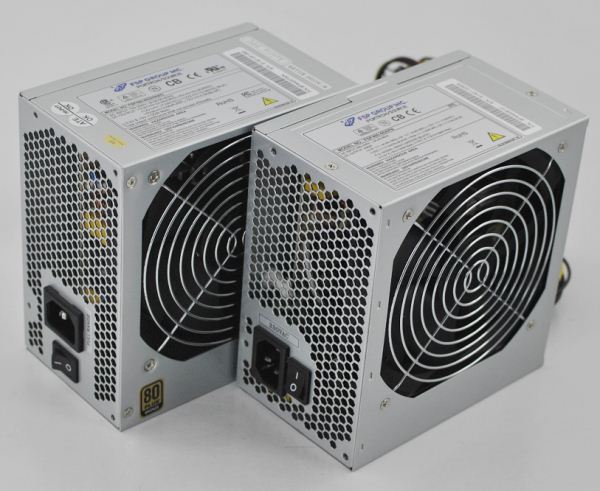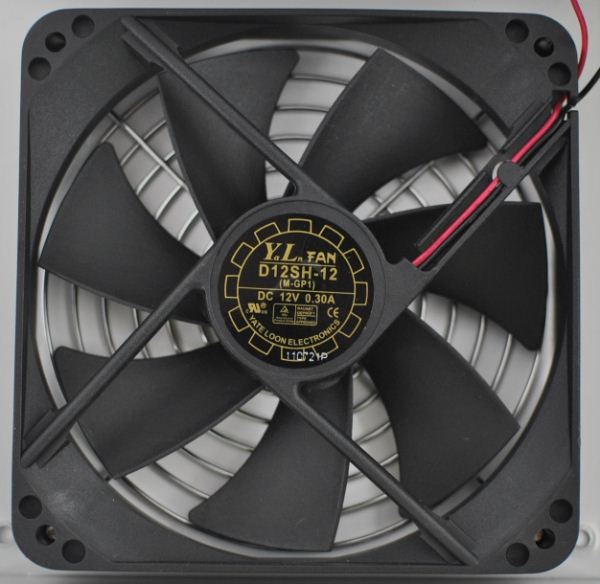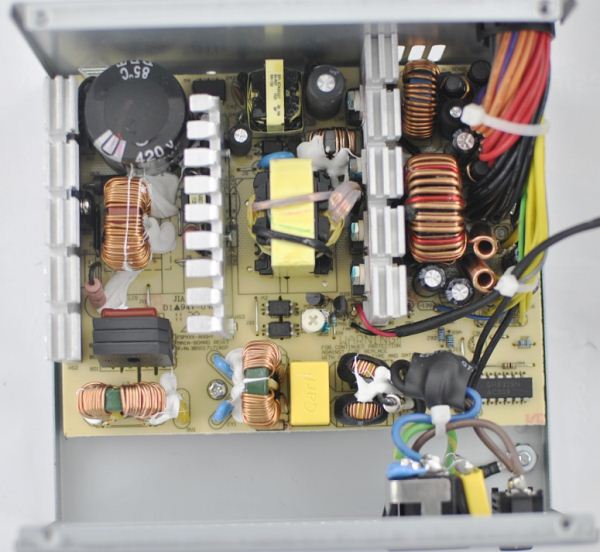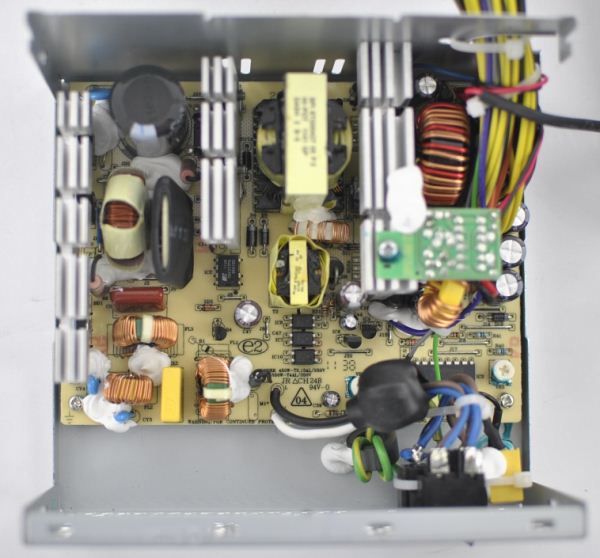350-450W Roundup: 11 Cheap PSUs
by Martin Kaffei on July 3, 2012 1:30 PM ESTFSP OEM 400W APN and GHN -1
FSP doesn't sell these OEM versions directly in the market. Instead, they find their way through various distributors and e-tailers to end-users. They come without any packaging because the companies want to keep this extra strictly to their retail version of the product. Therefore customers get a 2-year warranty. With 120W the 3.3V and 5V rails are rated somewhat lower than we're used to, but there's nothing to worry about since modern systems don't place a huge load on these rails anymore. The GHN model has no rating on 12V, the other one delivers 336W. FSP provides a low number of connectors for both products, but they are always able to customize the configuration e.g. by adding a 4+4-pin CPU connector for an OEM/ODM customer.
This Yate-Loon fan with the model number D12SH-12 and 120mm diameter uses sleeve bearings and seven fan blades. The maximum speed is 2200rpm at +12V. The subjective loudness of the fan (and the electronics of course) will be investigated on the following page.
| Cables and Connectors APN | ||
|
Connector type (length) |
Main | 1x 24-pin (50cm) fixed |
| ATX12V/EPS12V | 1x 4-pin (50cm) fixed | |
| PCIe | 1x 6-pin (40cm) fixed | |
| Peripheral | 3x SATA (ca. 40, 60, 80cm) fixed | |
| 2x HDD, 1x FDD (ca. 40, 60, 80cm) fixed | ||
| Cables and Connectors GHN | ||
|
Connector type (length) |
Main | 1x 24-pin (45cm) fixed |
| ATX12V/EPS12V | 1x 4-pin (50cm) fixed | |
| PCIe | 1x 6-pin (50cm) fixed | |
| Peripheral |
2x SATA, HDD (ca. 30, 45, 60cm) fixed 1x SATA, HDD, FDD (ca. 50, 65, 80cm) fixed |
|
| 2x HDD, 1x FDD (ca. 50, 65, 80, 95cm) fixed | ||
FSP400-60GHN(85)
FSP400-60APN (230V version)
The internal layout consists of three large heatsinks. Both main caps are made by CapXon and rated at 420V. It's also easy to spot the secondary capacitors and their respective manufacturers. FSP uses different suppliers for these PSUs, a few from Teapo and some from CapXon, both of which we have seen many times lately. Since the basic designs are several years old now, we didn't expect to find anything extraordinary within the design. However, both PSUs are still sold today and you can expect good quality from PSUs that use it.




















67 Comments
View All Comments
arthur449 - Tuesday, July 3, 2012 - link
I'm not sure how hard it would be, but would it be possible to write up a review of a few PicoPSU adapters? I've considered a few for low-power builds, but I've always been wary of the little no-name sealed plastic bricks that come with them.Then again, I don't know if Anandtech would be the ideal audience for such a review.
clarkn0va - Friday, July 6, 2012 - link
Ditto. I own a wide variety of PicoPSU and other related electronics from mini-box/ituner, as well as some similar Antec DC-DC products. I would love to see more of this stuff reviewed, with some emphasis on the "black box" bricks that can be had for very little outlay in some cases.freezervv - Tuesday, July 3, 2012 - link
> I'm not sure how hard it would be, but would it be possible to write up a review of a few PicoPSU adapters?This!! Please.
It's difficult to find information on suitable adapters, and it's kind of a critical part of the build given how little PicoPSUs filter their input (afaicr).
Machelios - Tuesday, July 3, 2012 - link
I noticed that the enermax PSU that you reviewed is not the same as the one on newegg. In the gallery, (this pic:http://www.anandtech.com/Gallery/Album/2123#7) the model is ENP450AWT.
However, you say you are revieweing the ENP450AST, which is the one available on newegg.
The ENP450AST (newegg link:http://www.newegg.com/Product/Product.aspx?Item=N8... lacks the 80 plus bronze certification and has less sleeved cables as far as I can see.
So, it seems you have reviewed the wrong psu...
Machelios - Tuesday, July 3, 2012 - link
sorry, the link was wrong for the psu on newegghere is the right one: http://www.newegg.com/Product/Product.aspx?Item=N8...
Martin Kaffei - Tuesday, July 3, 2012 - link
I love those manufactureres with hundreds of versions. Ironically they didn't want me to review their Triathlor 385W as it is "not available in the US".The AST is also a good PSU.
However, pricing will be a problem now.
Thank you for this correction.
Flashfir - Tuesday, December 1, 2015 - link
AST is also a good PSU eh? I trust you know what you're talking about - care to elucidate? I shared this on this thread in slickdeals and your post/comment about the Enermax will get some attention there so your comments would be much appreciated by many ;)http://slickdeals.net/f/8336981-enermax-naxn-enp45...
augiem - Tuesday, July 3, 2012 - link
I find that the one crucial point missing in ALL computer hardware reviews is long term reliability. It's understandable given the circumstances, but I wish there were some way for hardware reviewers to do some kind of simulated stress testing. I have found over the years, especially with motherboards and power supplies, that the reviews that award winners based on their feature set don't always do well long-term. The only way I've found to get an indication of this factor is through user reviews, which is not a perfect either as most reviews posted a few months past initial purchase are negative. Still it gives me a little better way to compare.I personally have had quite numerous failures 6 months+ out with excellently reviewed hardware, especially when its a lesser-known brand or a newcomer to the field.
piroroadkill - Tuesday, July 3, 2012 - link
You can get some idea from the quality of components used, the soldering, and so on..But yes, a soak test would be nice.
HardOCP does something close to this - their Torture Test - 8 hours @ 80% load, which is quite a nice test. Maybe something like this but for a bit longer?
Maybe with a high ambient temperature.. Maybe some power cycling during the test (to full cold, then back on again) to test cold joints and how well the PSU copes with heat cycling.
I don't know, just some ideas. But yeah, these tests would quite a bit of time.
arthur449 - Tuesday, July 3, 2012 - link
Look at the product's warranty and its terms and conditions. Pay close attention to how long the warranty lasts on replacements. A 5-year warranty doesn't mean much if they're only guaranteeing the replacement for 90-days. The longer a company is willing to allow easy and (mostly) free replacement of the product, the longer they're guessing it should last. Divide product price by the number of years the company allows hassle-free replacement for a rough estimate of long term value.Of course, this doesn't apply to new brands that simply haven't been around for very long, or brands that are simply rebadging cheap 'no-name' vendors.